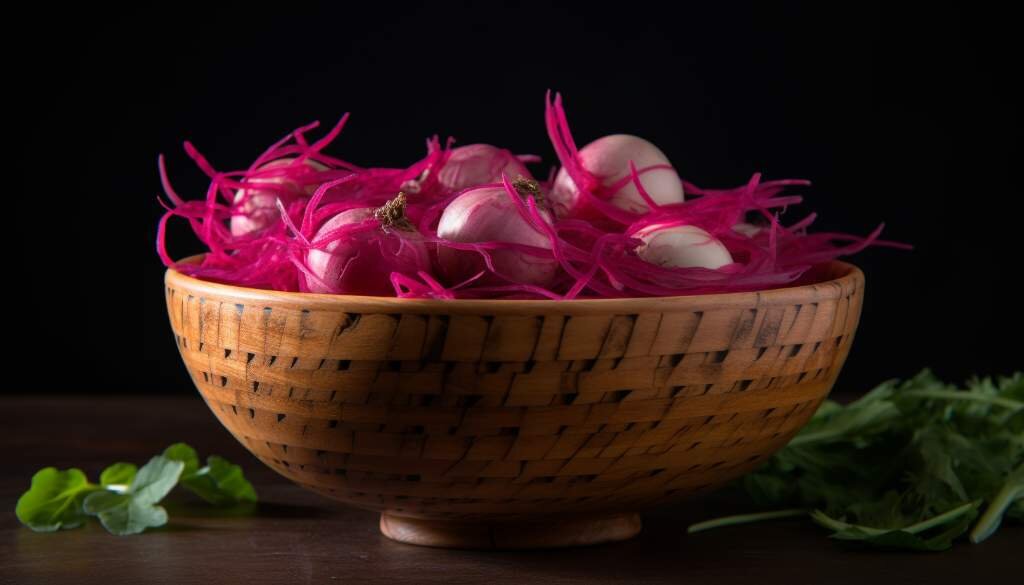
Introduction
Are you curious about whether you can eat turnips raw? In this article, we will unravel the truth and benefits of consuming raw turnips. Turnips are root vegetables that have a crisp texture and a mildly sweet and peppery flavor. They are packed with essential nutrients and offer numerous health benefits. If you're looking to add variety to your diet and explore new flavors, raw turnips can be a great addition.
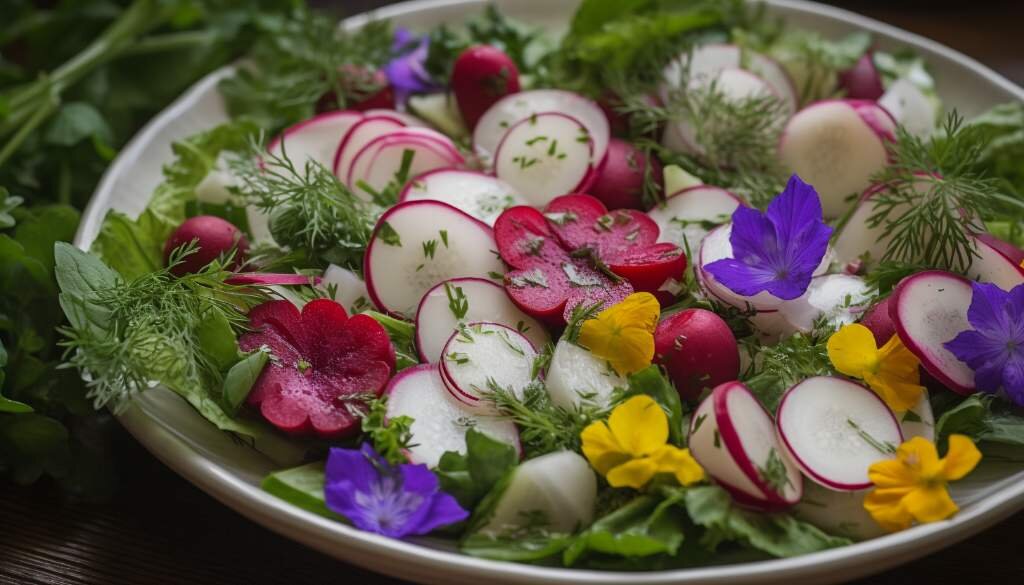
What Are Turnips?
Turnips are root vegetables that belong to the Brassicaceae family, which also includes vegetables like cabbage, broccoli, and kale. They are known for their crisp texture and slightly bitter, peppery flavor.
These bulbous vegetables come in various colors, including white, purple, and yellow. They have a round shape and smooth skin, while the inner flesh is usually white or cream-colored.
Turnips have been cultivated for thousands of years and are enjoyed in many culinary dishes around the world. They are versatile vegetables that can be eaten raw or cooked in various ways to suit different tastes and preferences.
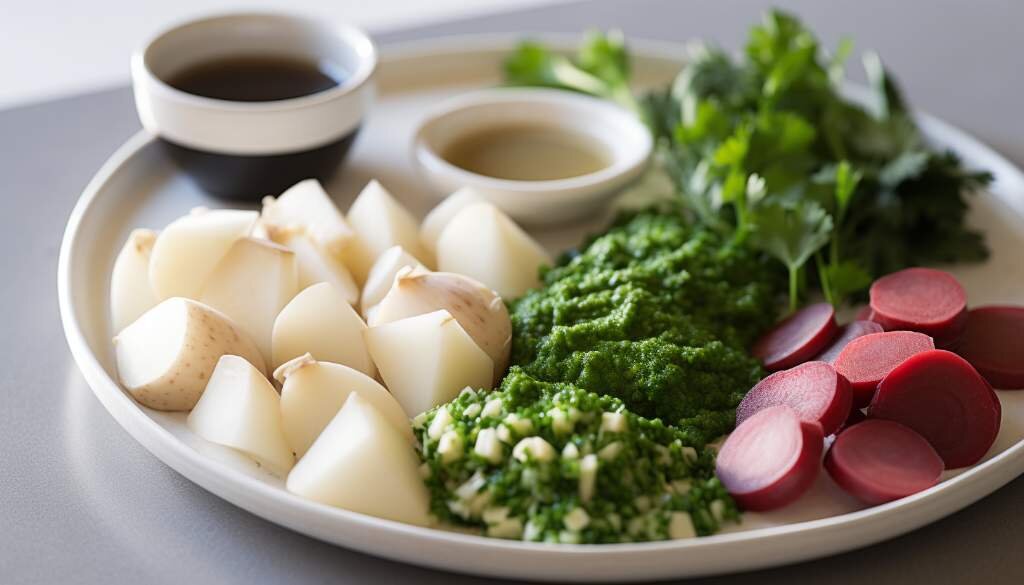
Nutritional Value of Raw Turnips
Raw turnips are a nutritious vegetable that can be enjoyed in a variety of ways. They are low in calories but packed with essential vitamins, minerals, and dietary fiber. Here is an overview of the nutritional value of raw turnips:
- Low in Calories: Raw turnips are an excellent choice for individuals looking to manage their weight. With only about 34 calories per 100 grams, they can be a satisfying addition to meals without adding excessive calories.
- Dietary Fiber: Turnips are a good source of dietary fiber, which is important for maintaining a healthy digestive system. A 100-gram serving of raw turnips provides about 1.8 grams of fiber, making it a great choice for promoting regular bowel movements and preventing constipation.
- Vitamin C: Raw turnips are rich in vitamin C, an essential nutrient that supports a healthy immune system and acts as an antioxidant, protecting the body against damaging free radicals. A 100-gram serving provides about 21 milligrams of vitamin C, which is approximately 35% of the recommended daily intake for adults.
- Potassium: Turnips are a good source of potassium, an electrolyte that plays a vital role in maintaining a healthy balance of fluids in the body. Potassium also supports nerve function and muscle contractions. A 100-gram serving of raw turnips contains around 233 milligrams of potassium.
- Vitamin K: Raw turnips are also a good source of vitamin K, which is essential for blood clotting and bone health. A 100-gram serving provides approximately 0.3 micrograms of vitamin K.
These are just a few of the key nutrients found in raw turnips. Incorporating them into your diet can provide a range of health benefits, which will be discussed further in the next section of this article.
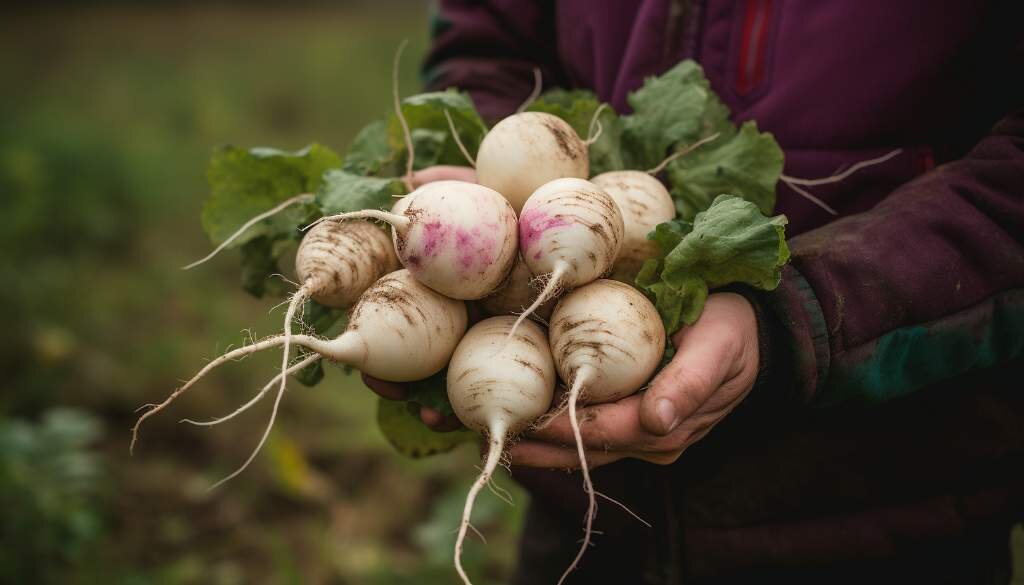
Health Benefits of Raw Turnips
Raw turnips are not only delicious but also packed with numerous health benefits. Here are some of the key reasons why you should consider incorporating raw turnips into your diet:
- High in Nutrients: Raw turnips are low in calories but high in essential nutrients. They are a good source of vitamins C, K, and E, as well as folate, potassium, and fiber.
- Boosts Digestive Health: The fiber content in raw turnips promotes healthy digestion and helps prevent constipation. It also supports the growth of beneficial gut bacteria.
- Supports Weight Loss: Raw turnips are low in calories and high in fiber, making them a great addition to a weight loss diet. The fiber helps you feel full for longer and reduces the overall calorie intake.
- Improves Heart Health: Raw turnips contain antioxidants that can reduce the risk of heart diseases. The potassium content helps regulate blood pressure.
- Rich in Antioxidants: Raw turnips are packed with antioxidants that help protect the body against free radicals and oxidative stress.
- Anti-inflammatory Properties: The phytochemicals present in raw turnips have anti-inflammatory properties, which can help reduce inflammation in the body.
Incorporating raw turnips into your diet can provide you with a range of health benefits, making them an excellent addition to a balanced and nutritious meal plan.
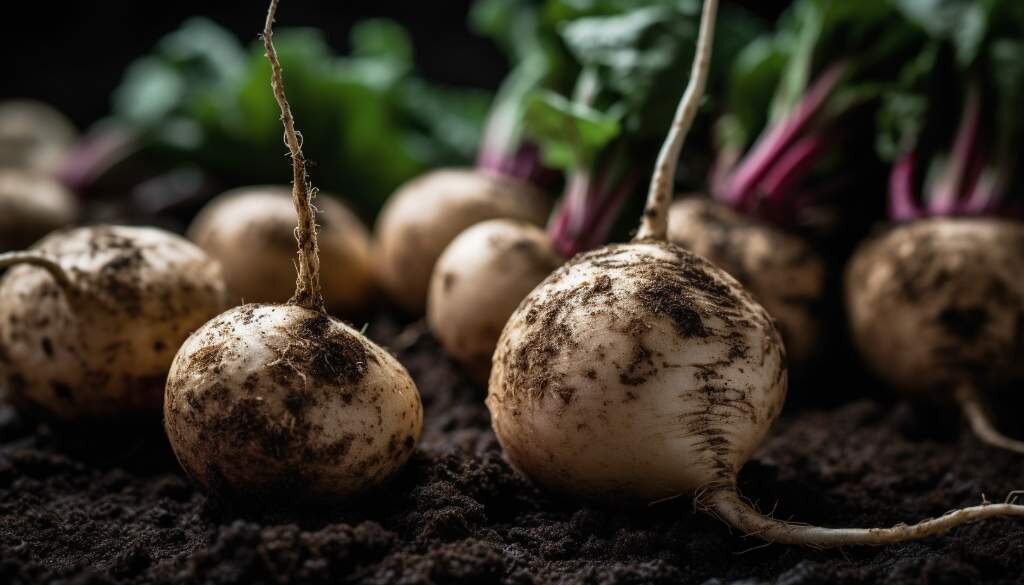
How to Prepare Raw Turnips
Raw turnips can be a delicious and nutritious addition to your diet. Not only do they provide a satisfying crunch, but they are also packed with vitamins, minerals, and fiber. Here are some simple steps to prepare raw turnips:
- Wash the turnips thoroughly under running water to remove any dirt or debris. You can use a scrub brush to gently clean the skin.
- Peel the turnips using a vegetable peeler or a sharp knife. This step is optional as the skin of turnips is edible, but peeling can enhance the texture and appearance of your dish.
- Trim off the top and bottom of the turnips and discard them.
- Slice or dice the turnips according to your preference. You can cut them into thin slices, matchsticks, or even grate them for salads or slaws.
- If you find the taste of raw turnips too strong or bitter, you can soak them in cold water for about 10-15 minutes. This will help mellow out the flavors.
Once you have prepared your raw turnips, you can enjoy them in a variety of ways. They can be eaten as a standalone snack, added to salads, or used as a crunchy topping for sandwiches and wraps. Raw turnips can also be grated and mixed with other vegetables to make a refreshing slaw. Get creative and experiment with different flavor combinations to find your favorite way to enjoy raw turnips!
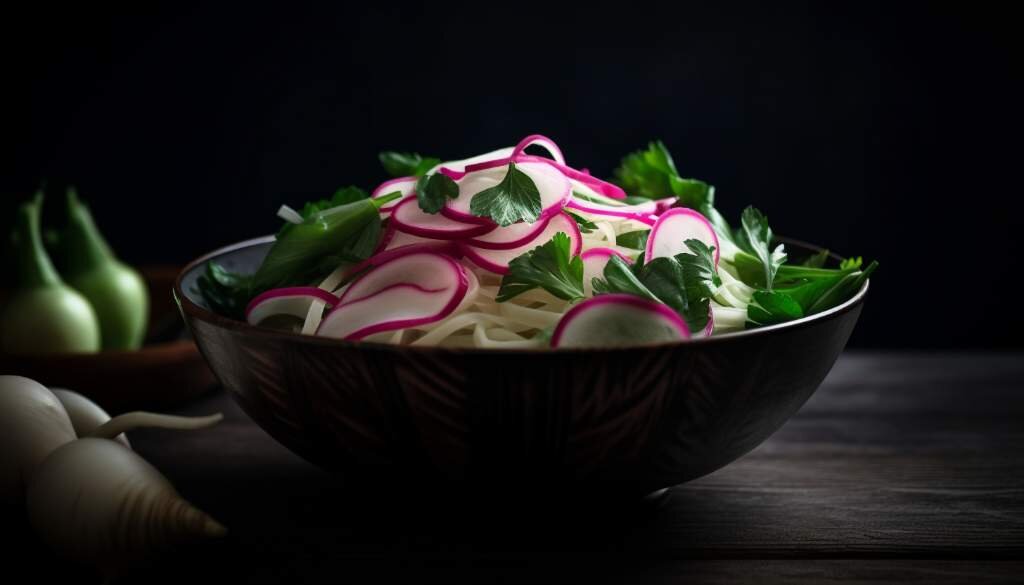
Tips for Incorporating Raw Turnips into Your Diet
Raw turnips can be a nutritious and delicious addition to your diet. Here are some tips on how to incorporate raw turnips into your meals:
1. Shred or grate them: Raw turnips can be grated or shredded and added to salads or coleslaws. They add a crisp texture and a slightly peppery flavor that complements other fresh ingredients.
2. Slice or julienne them: Thinly sliced or julienned raw turnips can be used as a crunchy topping for sandwiches or wraps. They can also be added to stir-fries for an extra crunch.
3. Use them as dippers: Cut raw turnips into sticks or slices and use them as a healthy alternative to chips or crackers. They can be dipped in hummus, yogurt-based dips, or even salsa for a nutritious snack.
4. Make turnip noodles: Spiralize raw turnips to create turnip noodles, which can be used as a low-carb substitute for pasta in stir-fries or salads. They have a mild taste and a satisfying crunch.
5. Blend them into smoothies: Add raw turnips to your favorite smoothie recipe for an extra boost of vitamins and minerals. They blend well with fruits and leafy greens, adding a unique flavor and texture.
6. Include them in crudité platters: Raw turnip slices can be served alongside other fresh vegetables on a crudité platter. They provide a refreshing and nutritious option for dipping into your favorite sauces or spreads.
7. Experiment with different seasonings: Raw turnips have a mild, slightly peppery flavor that can be enhanced with various seasonings. Try tossing them with olive oil, lemon juice, salt, and pepper for a simple yet flavorful salad.
With these tips, you can enjoy raw turnips in a variety of ways and reap the many nutritional benefits they offer!
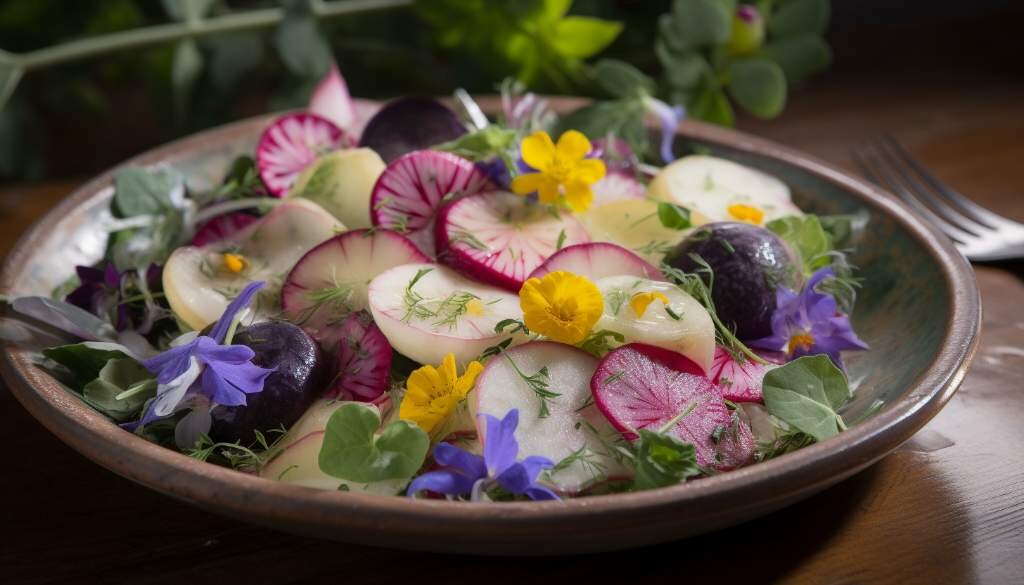
Are There Risks in Eating Raw Turnips?
Eating raw turnips can provide a crunchy and refreshing addition to your diet. However, it is important to be aware of the potential risks associated with consuming raw turnips.
One of the main concerns is the presence of goitrogens in raw turnips. Goitrogens are compounds that can interfere with thyroid function by inhibiting the uptake of iodine. This can potentially lead to goiter, which is an enlargement of the thyroid gland. In individuals with thyroid conditions, such as hypothyroidism or iodine deficiency, consuming large amounts of raw turnips may worsen their condition or potentially interfere with medication.
Another aspect to consider is the taste and texture of raw turnips. While some people enjoy the crispness and slightly peppery flavor of raw turnips, others may find them too bitter or pungent for their liking. It is important to consider personal preferences when incorporating raw turnips into your diet.
Additionally, raw vegetables can sometimes be challenging to digest for certain individuals. Some people may experience bloating, gas, or digestive discomfort after consuming raw turnips. If you have a sensitive digestive system or history of digestive issues, it may be beneficial to cook turnips before consuming them.
To minimize the risks and potential discomfort, you can take certain steps. Peeling and cutting the raw turnips into small, bite-sized pieces can make them easier to digest. Additionally, soaking them in water for a few minutes before consumption can help reduce their pungency and make them more palatable.
If you are unsure about consuming raw turnips or have any pre-existing health conditions, it is always recommended to consult with a healthcare professional or registered dietitian before making any significant changes to your diet. They can provide personalized guidance based on your specific needs and health status.
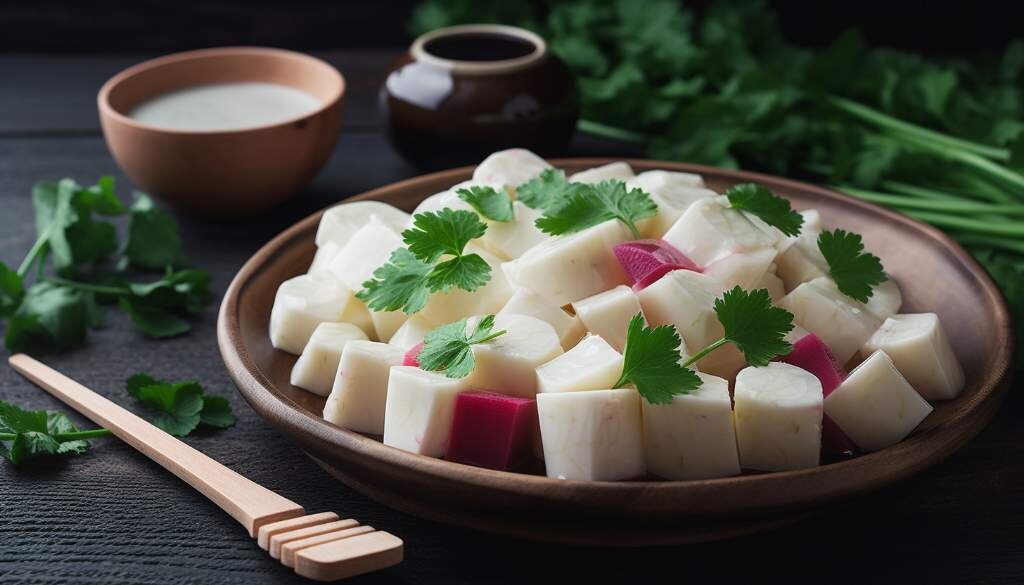
Cooking Turnips for Different Purposes
Cooking turnips for different purposes involves exploring various culinary techniques to bring out the best flavors and textures of this versatile root vegetable. From boiling to roasting, turnips can be transformed into delicious dishes that can be enjoyed in a variety of ways.
In the following sub-sections, we will explore some popular methods of cooking turnips:
- Boiled Turnips
- Roasted Turnips
- Turnip Fries
- Turnip Chips
- Mashed Turnips
- Turnip Coleslaw
- Turnip Gratin
Each of these methods creates unique flavors and textures, allowing you to experiment and find your favorite cooking style for turnips. Whether you prefer a simple boiled turnip, crispy turnip chips, or creamy mashed turnips, there are plenty of options to suit every palate.
Boiled Turnips
Boiled turnips are a versatile and delicious way to enjoy this nutritious vegetable. Whether you're looking for a simple side dish or a base for more complex recipes, boiled turnips are a great option. Here's everything you need to know about boiling turnips:
- Start by peeling the turnips and cutting them into cubes or slices. This will help them cook more evenly.
- Place the turnips in a pot of boiling water and cook for 10-15 minutes, or until they are tender but still firm.
- Drain the turnips and season them to your liking. You can add butter, salt, pepper, or herbs for extra flavor.
- Boiled turnips can be enjoyed on their own as a side dish, or they can be used in other recipes. They are a great addition to soups and stews, or they can be mashed and used as a healthier alternative to mashed potatoes.
- Boiled turnips are low in calories and high in fiber, making them a great option for those looking to maintain a healthy weight or improve digestion.
Roasted Turnips
Roasted turnips are a delicious and healthy way to enjoy this versatile root vegetable. Roasting brings out the natural sweetness of turnips and gives them a slightly caramelized flavor. Here's how you can roast turnips to perfection:
- Start by preheating your oven to 400°F (200°C).
- Wash and peel the turnips, then cut them into uniform pieces. You can slice them into rounds or cut them into cubes.
- Place the turnip pieces in a mixing bowl and drizzle them with olive oil. Toss the turnips in the oil until they are well coated.
- Season the turnips with salt, pepper, and any other desired spices or herbs. Thyme, rosemary, or garlic powder work well with roasted turnips.
- Spread the seasoned turnip pieces in a single layer on a baking sheet. Make sure they are not overcrowded to allow for even cooking.
- Place the baking sheet in the preheated oven and roast the turnips for about 25-30 minutes, or until they are tender and golden brown.
- Once the turnips are roasted to your desired level of crispiness, remove them from the oven and let them cool for a few minutes before serving.
Roasted turnips can be enjoyed as a side dish or used in various recipes. They add a delightful flavor and unique texture to salads, grain bowls, or as a standalone vegetable dish. Give roasted turnips a try and discover a new way to enjoy this nutritious root vegetable!
Turnip Fries
Turnip fries are a delicious and healthy alternative to regular potato fries. They are easy to make and can be enjoyed as a snack or a side dish. Here's how to make turnip fries:
- Preparing the turnips:
- Start by selecting fresh and firm turnips. Look for ones that are free from blemishes or soft spots.
- Wash the turnips thoroughly and peel off the skin using a vegetable peeler.
- Cut the turnips into thin, fry-like strips. You can make them as thick or thin as you prefer.
- Seasoning the fries:
- In a bowl, toss the turnip strips with olive oil to coat them evenly. This will help them crisp up while baking.
- Add salt, pepper, and any other desired seasonings such as paprika, garlic powder, or rosemary. Toss again to distribute the seasonings evenly.
- Baking the turnip fries:
- Preheat your oven to 425°F (220°C).
- Line a baking sheet with parchment paper or foil to prevent sticking.
- Arrange the seasoned turnip strips in a single layer on the baking sheet, making sure they are not overcrowded.
- Bake for about 20-25 minutes, flipping the fries halfway through, until they are golden brown and crispy.
- Serving and enjoying:
- Once the turnip fries are done, remove them from the oven and let them cool slightly.
- Serve them as a side dish with your favorite dipping sauce, such as ketchup, mayonnaise, or aioli.
- Turnip fries can also be enjoyed on their own as a healthy snack alternative to regular potato chips.
Turnip fries are a nutritious choice, as turnips are low in calories and high in fiber, vitamins, and minerals. They make a great addition to a balanced diet and can be customized with different seasonings to suit your taste preferences. So, give turnip fries a try and enjoy a tasty and nutritious alternative to traditional potato fries.
Turnip Chips
Turnip chips are a delicious and healthier alternative to traditional potato chips. They are crispy, flavorful, and easy to make. Here's how you can make turnip chips at home:
- Choose fresh and firm turnips for the best results. It's important to select turnips that have a smooth skin and are free from any blemishes.
- Wash the turnips thoroughly to remove any dirt or residue. You can peel the skin if you prefer, but leaving it on will add extra fiber to your chips.
- Using a sharp knife or a mandoline slicer, slice the turnips into thin, even slices. The thickness of the slices will determine how crispy the chips will be, so try to make them as uniform as possible.
- Preheat your oven to 375°F (190°C).
- Place the turnip slices on a baking sheet lined with parchment paper, making sure they do not overlap. This will allow the air to circulate and crisp up the chips evenly.
- Drizzle the turnip slices with a small amount of olive oil and sprinkle them with your preferred seasonings. You can use salt, pepper, garlic powder, paprika, or any other spices you like.
- Bake the turnip chips in the preheated oven for about 15-20 minutes, or until they turn golden brown and crispy. Keep an eye on them as they can quickly burn.
- Once the turnip chips are done, remove them from the oven and let them cool for a few minutes before serving. They will continue to crisp up as they cool.
Turnip chips make a great snack on their own or as a side dish. They are low in calories, high in fiber, and packed with nutrients like vitamin C, potassium, and calcium. Enjoy them as a healthier alternative to potato chips or add them to salads for an extra crunch.
Mashed Turnips
Mashed turnips are a delicious and nutritious way to enjoy this root vegetable. While turnips are often cooked in various ways, including boiling and roasting, mashing them creates a smooth and creamy texture that is reminiscent of mashed potatoes. Here are some key points to know about making mashed turnips:
- Start by peeling and chopping the turnips into small, even-sized pieces. This will ensure that they cook evenly and mash easily.
- Place the chopped turnips in a large pot and cover them with water. Bring the water to a boil and cook the turnips until they are tender when pierced with a fork. This usually takes about 15-20 minutes.
- Once the turnips are tender, drain them well and return them to the pot. Use a potato masher or a fork to mash the turnips until they reach your desired consistency. If you prefer a smoother texture, you can use a blender or food processor.
- Add butter, salt, and pepper to taste. You can also add other seasonings like garlic powder, thyme, or Parmesan cheese for extra flavor.
- Serve the mashed turnips hot and enjoy them as a side dish with your favorite protein or as a vegetarian main course.
Turnip Coleslaw
Turnip coleslaw is a delicious and refreshing twist on traditional coleslaw. It is a great way to incorporate raw turnips into your diet and enjoy their crunchy texture and mild flavor. Here are some tips on how to make turnip coleslaw:
- Ingredients:
– 2 large turnips, peeled and grated
– 1 carrot, peeled and grated
– 1/4 cup mayonnaise
– 2 tablespoons apple cider vinegar
– 1 tablespoon honey
– Salt and pepper to taste
– Optional: add-ins such as shredded cabbage, chopped celery, or sliced radishes - Preparation:
– In a bowl, combine the grated turnips and carrot.
– In a separate bowl, whisk together the mayonnaise, apple cider vinegar, honey, salt, and pepper until well combined.
– Pour the dressing over the grated turnips and carrot and mix until everything is evenly coated. - Flavor Variations:
– For a tangier coleslaw, add a squeeze of fresh lemon juice or a tablespoon of Dijon mustard to the dressing.
– To add some extra crunch, mix in chopped walnuts, sliced almonds, or sunflower seeds.
– For a sweeter coleslaw, replace the honey with maple syrup or agave nectar. - Serving Suggestions:
– Turnip coleslaw can be enjoyed on its own as a side dish or added to sandwiches, wraps, or burgers for added flavor and crunch.
– It pairs well with grilled meats, fish, or tofu, adding a refreshing and healthy element to the meal.
– Feel free to get creative and experiment with different herbs and spices such as dill, parsley, or paprika to customize the flavor to your liking. - Storage:
– Turnip coleslaw is best served fresh, but if you have leftovers, store them in an airtight container in the refrigerator for up to 2 days.
– Keep in mind that the longer it sits, the more the dressing will soften the vegetables, so it may lose some of its crunch.
In summary, turnip coleslaw is a simple and tasty way to enjoy raw turnips. Its refreshing flavor and crunchy texture make it a great addition to any meal. So why not give it a try and unlock the potential of raw turnips in your diet?
Turnip Gratin
Turnip gratin is a delicious and satisfying dish that can be enjoyed as a main course or served as a comforting side dish. It is a popular dish in many cuisines and is often made with layers of sliced turnips, cream, cheese, and breadcrumbs. Here's how you can prepare a mouthwatering turnip gratin:
- Preheat your oven to 375°F (190°C) and grease a baking dish with butter or cooking spray.
- Peel and slice the turnips into thin rounds. You can use a mandoline slicer for consistent thickness.
- In a small saucepan, heat some heavy cream over medium heat until it starts to simmer. Add salt, pepper, and any desired herbs or spices for added flavor.
- Arrange a layer of sliced turnips in the greased baking dish, slightly overlapping the slices.
- Pour a generous amount of the seasoned cream over the layer of turnips until they are well coated.
- Sprinkle some grated cheese, such as Gruyere or Parmesan, over the cream.
- Repeat the layers, alternating between turnips, cream, and cheese until you have used up all the ingredients or reached the desired thickness.
- Finish with a layer of cheese and sprinkle breadcrumbs on top for a golden crust.
- Cover the baking dish with foil and bake in the preheated oven for about 30 minutes.
- After 30 minutes, remove the foil and continue baking for another 15-20 minutes, or until the top is golden brown and the turnips are tender.
- Let the gratin rest for a few minutes before serving to allow the flavors to meld together.
Turnip gratin is a versatile dish that pairs well with a variety of main courses. It can be served alongside roasted meats, grilled chicken, or enjoyed on its own as a vegetarian option. The creamy, cheesy texture combined with the earthy flavor of turnips makes this dish a crowd-pleaser.








